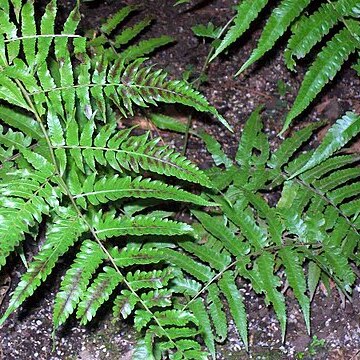Plants terrestrial, evergreen, medium-sized to large. Rhizome creeping to ascending or erect, sometimes subarborescent, brown or nearly black, dictyostelic, ± scaly; scales subulate, lanceolate, or broadly lanceolate, sometimes ovate and adpressed or peltate, margin entire, sometimes sparsely toothed and often narrow, black, brown, yellow-brown, or dark brown to black; fronds caespitose, distant or approximate. Stipe brown or black and scaly at base, scales similar to those on rhizome, and upward gradually glabrescent or with sparse scales, sometimes base and upward prickly, grooved adaxially, not hairy. Lamina mostly broadly ovate, oblong, or deltoid, sometimes broadly lanceolate, usually pinnate to tripinnate-pinnatifid under acuminate and pinnatifid apex, mostly bipinnate or bipinnate-pinnatilobate to bipinnate-pinnatipartite. Pinnae lanceolate, broadly lanceolate, or oblong-lanceolate, base mostly or nearly symmetrical, lower pinnae not reduced or slightly reduced; ultimate pinnules mostly lanceolate or broadly lanceolate, sometimes ovate or oblong, base stalked or sessile, truncate, rounded, or subcordate, margin entire or serrate, apex acute or acuminate to long acuminate, sometimes rounded or truncate; veins free, rarely anastomosing with a row of areoles along costa and costule; veinlets simple or forked, ascending, lower veinlets often curved. Lamina herbaceous or papery, rarely leathery, usually glabrous, rachis, costae, and costules abaxially sometimes with sparse subulate or lanceolate scales, rarely prickly; rachis, costae, and costules adaxially grooved between knife-edgelike ridges, ridges interrupted at insertion of higher-order frond axes, so grooves continuous, both surfaces of costa often with minute glandular hairs. Sori linear, oblong, or ovate, mostly single or less often double on basal acroscopic veinlets, costular, medial, supramedial, or from base to end of veinlets; indusia membranous or thickly membranous, grayish white or brown, vaulted or ovoid when mature, and irregularly rupturing on back, or compressed, linear, opening acroscopically, persistent or caducous. Spores bilateral, monolete, mostly reniform or bean-shaped, sometimes hemispherical, rarely spherical; perispore generally prominent, ornamentation mostly rugate, glabrous or aculeate, granular, clathrate, reticulate, rarely ridged. n = 41.
More
Terrestrial ferns. Rhizome usually erect, sometimes forming a small trunk, occasionally creeping, scaly; scales entire or toothed. Fronds widely spaced to crowded. Stipe tuberculate or spinulose, scaly; scales borne on small protuberances. Lamina 1–4-pinnate, occasionally simple and entire, thin to coriaceous, sometimes proliferous towards the apex; grooves of primary and secondary rachises continuous, those of lesser rachises and costae not continuous; veins mostly free, occasionally anastomosing. Sori elongate on the veins; lowest pair of a group often united; indusium linear.
Double sori (on both sides of a vein) not connected at their distal ends.

